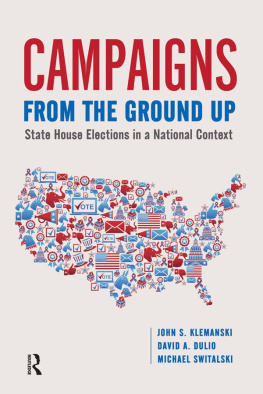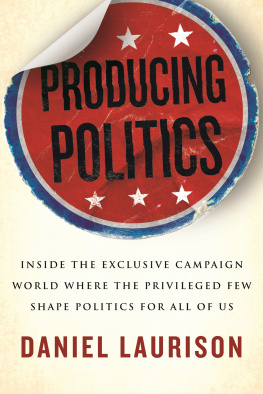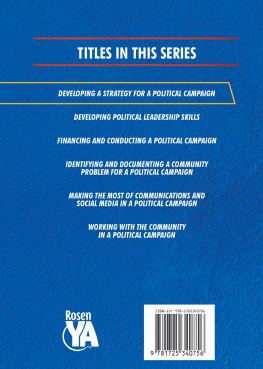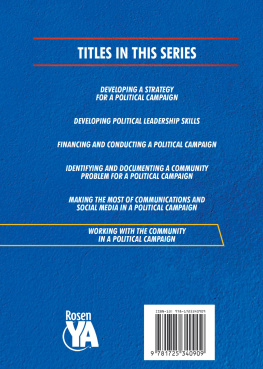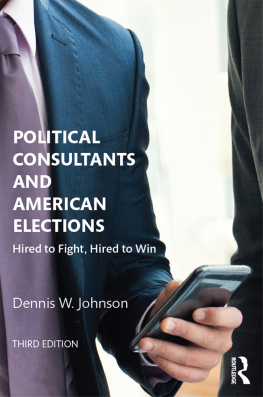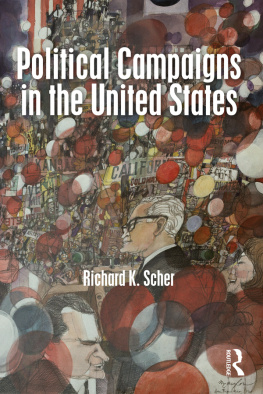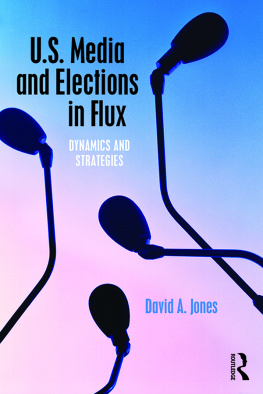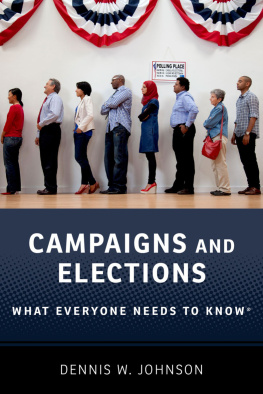CAMPAIGNS FROM THE GROUND UP
Pathways of Politics
Daniel M. Shea, Series Editor
Pathways of Politics is a new series of books exploring key advances in the ability of average citizens to bring about meaningful change in American politics. The major routes of change included in the series are:
Elections
Litigation
Legislation and Lobbying
Grassroots Activism
Cultural Shifts
Titles in the Series
Campaigns from the Ground Up: State House Elections in a National Context
John S. Klemanski, David A. Dulio, and Michael Switalski
CAMPAIGNS FROM THE GROUND UP
STATE HOUSE ELECTIONS IN A NATIONAL CONTEXT

JOHN S. KLEMANSKI, DAVID A. DULIO, AND MICHAEL SWITALSKI
First published 2015 by Paradigm Publishers
Published 2016 by Routledge
2 Park Square, Milton Park, Abingdon, Oxon OX14 4RN
711 Third Avenue, New York, NY 10017, USA
Routledge is an imprint of the Taylor & Francis Group, an informa business
Copyright 2015, Taylor & Francis.
All rights reserved. No part of this book may be reprinted or reproduced or utilised in any form or by any electronic, mechanical, or other means, now known or hereafter invented, including photocopying and recording, or in any information storage or retrieval system, without permission in writing from the publishers.
Notice:
Product or corporate names may be trademarks or registered trademarks, and are used only for identification and explanation without intent to infringe.
Library of Congress Cataloging-in-Publication Data
Klemanski, John S.
Campaigns from the ground up : state house elections in a national context/John S. Klemanski, David A. Dulio, and Michael Switalski.
pages cm. (Pathways of politics)
Includes bibliographical references and index.
ISBN 978-1-61205-691-3 (hardcover : alk. paper)
1. ElectionsUnited StatesStates. 2. State governmentsUnited States.
3. Campaign managementUnited StatesStates. 4. Political campaignsUnited StatesStates. I. Title.
JK1967.K6 2014
324.70973dc23
2014026451
ISBN 13: 978-1-61205-691-3 (hbk)
ISBN 13: 978-1-61205-692-0 (pbk)
For James, Cheryl, Lisa, Aaron, Paul, Corinne, and Perry (JSK)
For Abby and Sophia (DAD)
For my wife Roma (MS)

CONTENTS

Regular, fair, and competitive elections are considered to be a foundation of modern democratic theory and practice. As such, a large portion of political science research and literature is devoted to elections and the associated topics of political participation and voter turnout, voting rights, redistricting, incumbency, and political advertising, among many others. Moreover, media coverage of electionsespecially presidential electionsdominates the news in the months prior to Election Day.
This book focuses on what we consider to be an equally important element of democratic electionsthe practical aspects of the political campaigns that are waged when trying to attract voter attention and support. While always important, we believe that the activities and conduct of political campaigns have become increasingly important in competitive races, especially with the expanded number of information sources provided by the Internet, the presence of a twenty-four-hour news cycle, the continued practice of the permanent campaign in the United States, and many other factors. With these dynamics in place, the effectiveness of campaign messages and the strategic choices that campaigns make have become even more crucial to the electoral success of candidates. Modern campaigns must be organized and prepared, and they must be able to use available knowledge and technology to reach voters and make sure their supporters vote on Election Day.
To help illustrate this point, this book centers on the creation of a campaign plan in a simulation setting. A campaign plan is essential to effective campaigning, as it provides a reasoned and rational place for decision making during what is typically a chaotic timethe campaign season. Without a campaign plan, a political campaign is likely to only react to events around them, spend money unwisely, stay in a defensive mode throughout the campaign, and engage in other activities that make winning less likely. As you will discover, conducting research is an important part of creating a campaign plan. There are many different kinds of research involved in creating a campaign plan, including research designed to provide insight on a district and its voters, the opponent (as well as ones own candidate), and the political environment in which the campaign will be waged (for example, is it taking place during a presidential election year, which will likely increase voter turnout?).
This volume is the offspring of The Mechanics of State Legislative Campaigns (Klemanski and Dulio 2006). While we continue the emphasis on campaign plans with this book, the many changes in campaigns and elections since the publication of Mechanics have prompted us to write a new book that accounts for these developments. Since 2006, much has happened to alter the campaign and election landscape in the United States. We elected an African American presidenttwice. The rise of social media has changed the ways in which campaigns raise money and communicate with supporters and potential voters. In fact, Barack Obamas social media superiority over his opponents in both 2008 and 2012 is regarded by some observers as an important reason for his victories (Rutledge 2013). Social medias potential in political campaigns appears to be almost without limit, as both a means to communicate with and mobilize supporters and as a low-cost way of raising campaign contributions.
While Twitter is often thought of as the communication playground of pop-culture celebrities, one of the most re-tweeted tweets in history was Barack Obamas Four More Years message after his reelection in 2012. The potential exists for this kind of technology to have great impact in state-level campaigns as well, if only because the costs are so low. While it costs thousands of dollars to air a broadcast television commercial, there is next to no cost to establishing a campaign Twitter handle or creating a campaign Facebook page. There are problems lurking in all of this potential, however. One problem is simply how difficult it is for a campaign to attract the attention of potential votersespecially in the midst of all the other social media messages and additional media and information clutter that exists. Also, campaigns must be vigilant about the content of their postings. We have included some exercises involving social media in our crisis management section in an effort to illustrate potential problems and how to respond to them.
Other changes since the publication of the Mechanics book in 2006 include various revisions to state election laws in many states. For example, Colorado and Washington have joined Oregon to become universal vote-by-mail states. In addition, beginning with the 2012 elections, California began using a top-two primary system in which candidates from all parties compete against each other in primary elections. This means two Republicans or two Democrats could compete against each other in a general election. Continued use and some expansion of election reforms, such as early in-person voting, Election Day registration, and no-excuse absentee voting, were also part of the election process in a number of states. During this same time (and especially after the 2010 elections), a number of states adopted stricter voter identification laws, requiring that voters present state-approved photo identification documents at the polls. Each of these election law changes can have an effect on how a political campaign tries to reach voters, as well as how and when voters need to be contacted and mobilized.

